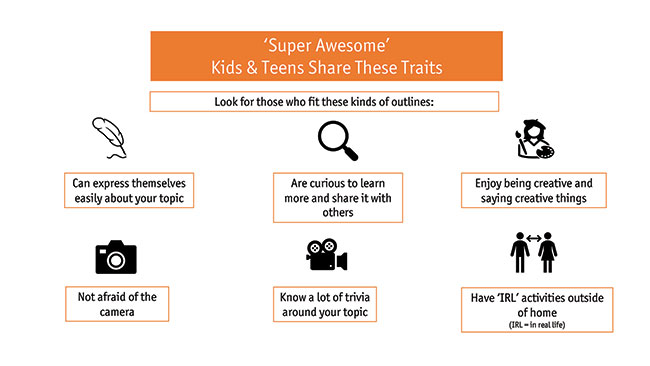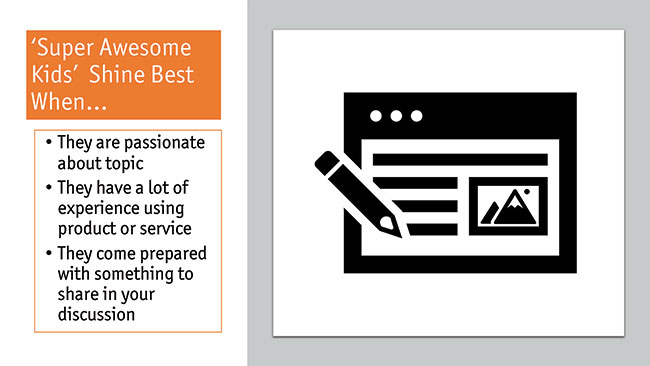How do you top your nachos?
Editor's note: Pam Goldfarb Liss is a freelance qualitative researcher and president of research firm LitBrains-Igniting Ideas!
Finding “super awesome kids” for your qualitative research studies is akin to tracking down the Holy Grail – and if you discover this treasure, you’ll have engaging young people who will give you important perspectives for any business strategy you or your client are investigating. You know who these respondents are: They are articulate, savvy kids or teens who are able to provide the perspectives needed in a research study. They get it. They can tell you about their own personal opinions easily and know what they’re talking about. They are key to the success of any qualitative research event.
My hope with this article is to give you a two-part process for designing the plan that will help you find your super awesome kids. Part one is defining the right respondents for your study. Part two is preparing your respondents so they can confidently share their own opinions. By doing this work upfront, you will help your young respondents be the awesome kids your project needs and make them feel more comfortable giving their great perspectives.
Clear in your screening
The wonderful thing about kids and teens is, unlike adults, most of them are exactly who they say they are. Thus it’s even more important to ensure you are clear in your screening questionnaire. A recruiter who has been briefed on the qualities you are looking for in these special kid or teen respondents is equipped to make it happen.
Think of recruiting as the first part of this journey. The metaphor I’ll use a few times in this article is nachos. Nachos are nachos, yes, but there are all sorts of toppings and sauces you can use to make them the great-tasting version you personally want, right? Similarly, you need to customize your screening questionnaire with specific things that will help you get the great kid respondents you need for your project.
Please remember that a recruiter is only as good as the screening questionnaire you give them. With kids, this is even more important, as best-practices require a two-part and time-consuming recruiting process of speaking with parents first about usage context and qualification and follow-up directly with kids or teens for articulation and creativity. Allow for the time to recruit these kids, with three weeks to accommodate the various wait-times needed to get ahold of everyone.
Again, if you supply your recruiter with clear outlines and examples of the kinds of kids and teens you want in your group, you’ll get the great kids you’ve envisioned, especially with a few tricks:
Ask mom and dad about them. In recruiting for super awesome kids, mom and dad are important. Parents know their child’s overall ability to collaborate and share opinions. Parents know how much their kids use the product or service. If a parent is hesitant or unclear at any time during the screening questions, a recruiter should be free to disengage and move on. Empower your recruiters to judge – with your guidance, through examples of different nuances to watch out for – throughout your screener. A recruiter who knows what to listen for from parents and kids will get you great respondents.
Give them an audition. It is very important to look at the screening time with kids as a sort of audition. Plan for five questions. Make two of the five about articulation and on-the-spot creativity in open-ends. You know the ones: If you met an alien, what would you tell them is needed to make the best nachos? Or, if you could make the best nachos, what would you include in the recipe and why?
Help your recruiters. In recruiting for the super awesome kid, you should offer guidance to the recruiters in screener questions with open-ends. These recruiter notes underneath the screener question should make it clear that a child who might answer that nachos are made with just cheese and tortilla chips is not the kid you want in your group. You will mention in those recruiter notes that the kid who describes nachos with a specific cheese and uses well-chosen adjectives for the gooeyness of said cheese, along with detailing special additions like chili and layers of other items, is the respondent you want in your group. When your recruiter understands the kinds of respondent you want, everybody wins.

A side note: Be careful about recruiting for super awesome kids in friendship pairs. It takes longer to find these pairs and it’s very difficult to capture lightning in a bottle twice. Friends don’t often have differing opinions or even the same abilities to articulate them. Depending on my client’s topic, for better-quality kids and differing perspectives, I often counsel clients to look at recruiting great kids who may not know each other beforehand. It is often a win-win if you can recruit articulate and passionate kids from different friendship circles. I do, however, love friendship pairs when talking about matters like race, abilities, education and hygiene that require sensitivity and connection to share. Be careful in considering recruiting approach because it is important to go for quality kids first.
The super awesome kid recruited using the strategies above becomes a true asset to any qualitative research project. I love moderating when the recruiting process has gone flawlessly with kids and teens because the enlightened client who hears from one of these kids is always better for their perspective.
Need a little preparation
Unlike adults, kids need a little preparation to offer you the best insights. If conducting online communities or asynchronous qualitative research studies, preparation should be scheduled into the first day of research contributions to allow that peek into their everyday lives. If conducting live studies, homework or even a quick lobby survey prior to your qualitative research event makes a huge difference to move kids into thinking in the context of your study. It should be fun for them to share a bit about themselves with you. It should allow you a glimpse into their day-to-day. It should get kids thinking about the subject you want to learn more about in your study.

As an example of the kind of insight that can surface during pre-work, in a recent study for a kid-favored dessert product, pre-teens provided fun love letters to their favorite dessert and sent us photos, drawings and videos, narrating in their own language the shelves and cupboards of their snack cabinets and, most importantly, mom’s private snack/dessert stash. This pre-work got our clients to acknowledge that moms buy the product as guilty pleasures for them as much as for their kids and gave our clients a fun platform to market the snacks not just to kids who love them for their delicious flavors but as a treat for moms too – something that would not have been revealed in our live online group discussion as it could potentially embarrass the moms.
Here are some additional suggestions:
- Open up pre-work assignments to their creativity and customization. Super awesome kids will want to make the assignment their own – personalize it with their own drawings or ways of seeing the world. Create an assignment that allows them to do this, whether it is a homework task like a snack diary or a pre-shopping/I-spy assignment or even a lobby survey. These efforts can offer open-ends that help them get in the mode of thinking about the moments you’ll want to learn more about when you meet.
- Offer capability to work in multimedia. Super awesome kids are almost universally more able to express themselves using multimedia than most adults. This gives an even more exciting voice-of-the-consumer contribution to your study than anything you could ask them in an interview. When I can allow these kinds of pre-work assignments, I get a variety of helpful videos and drawings that provide really good dimension and context around an experience.
- Be flexible about submission deadlines. Kids and teens are overscheduled. Parents are protective about this. As a researcher, you will always get better and more fully thought-out ideas from a participant who has time to think about your questions. If possible, provide plenty of time for kids and teens to answer your questions. A week is ideal. If possible, allow parents to participate with kids. The project thinking will always be well-rounded when kids are partnered with their parents, who I’ve found rarely influence or bias but instead enhance their kids’ input.
Feel great about sharing
The result of taking these two simple steps before you even meet your respondents in any kid or teen qualitative research event is that you’ll have confident kids who will feel great about sharing their perspectives. Remember, kids are wonderful and with a little preparation you’ll have amazing insights into their lives.
